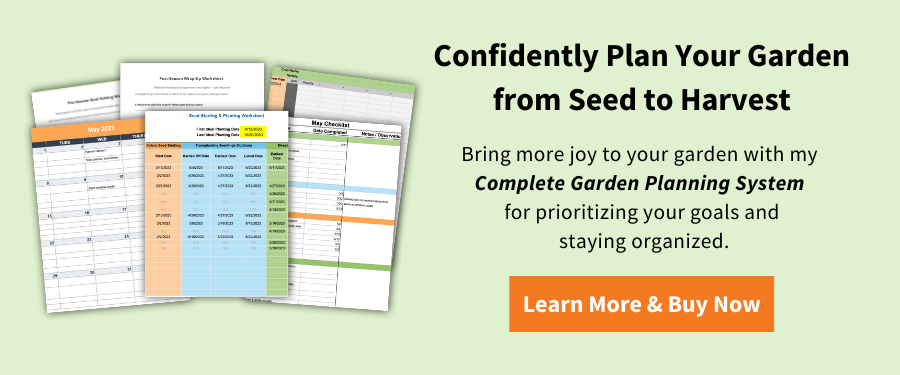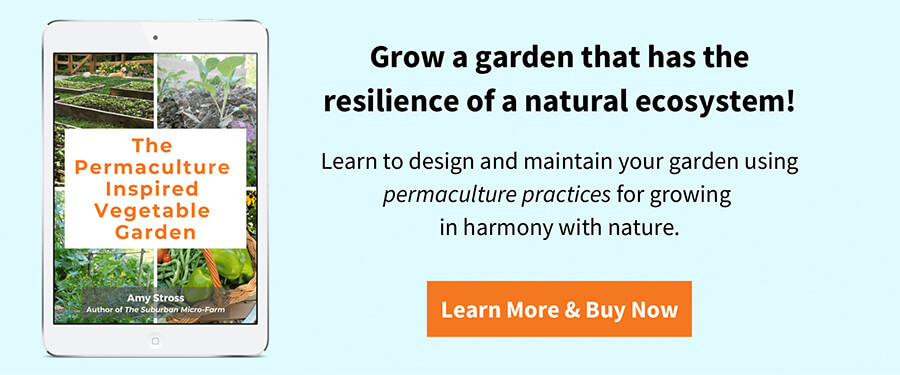Are Raised Vegetable Garden Beds Right For You?
Are raised vegetable garden beds right for your garden? If building garden beds is in your future, here are 11 benefits and 4 drawbacks for growing in raised beds.


This page may contain affiliate links. Please read my disclosure for more info.
Garden Bed Considerations
When you’re ready to start a garden and build garden beds, you’ll want to take stock of the following:
- How much rainfall you get (Annual rainfall in the U.S.)
- What your soil is like (clay, sand, loam, soil pH extremes, volume of organic matter)
- Terrain challenges (rocky terrain, high water table, slope)
- Barriers (physical limitations, contamination concerns)
- What’s under the proposed garden area (grass, vigorous weeds, pavement)
- The composition of the paths between garden beds (grass, dirt, wood chips, gravel)
All of this information will help you choose a garden bed style that is right for you.
11 Reasons to Grow in Raised Vegetable Garden Beds
Although there are many styles of beds, raised vegetable garden beds can be beneficial in a wide range of circumstances. It’s important to note that raised beds can be built with a variety of different materials.
Let’s take a look at the pros of growing in raised vegetable garden beds.
Pro #1: Improve Soil
Raised beds allow you to add organic soil amendments and compost (homemade or store bought) to build up and improve garden soil. Soil amendments added to in-ground beds, however, may fall away without the raised bed container to hold them in.
Many gardeners deal with challenges like heavy clay, extreme sand, pH challenges, or construction fill. Adding lots of organic matter is the fastest way to improve soil.
Side note: In a no-till garden, fungal networks and soil organisms release sticky exudates that hold soil together. These aren’t typically present in a new garden bed, which is why the raised bed frame can be so beneficial. Fungal networks develop in time and hold soil together (whether in a raised bed or an in-ground bed).
See: Transitioning to a No-Till Garden and How To Improve Clay Soil in 6 Steps


The process of building a raised vegetable garden bed at the end of my driveway is underway!
Grow a garden that’s both productive and manageable with my Complete Garden Planning System, which includes practical tools for planning your season from seed to harvest.
Pro #2: Outsmart the Rock with Raised Vegetable Garden Beds
Rocky soil can make life terrible at planting time. Raised vegetable garden beds allow deep roots to grow without an annual fight with the tiller or shovel. Win!
Along the same lines, if you are short on growing space, consider building raised beds on top of pavement. We had excellent results with 24-inch-high raised beds built at the end of our driveway.
Pro #3: Beat a Cold Spring
Raised beds heat up faster in the spring, resulting in a longer growing season in areas with long winters. Add a cold frame, and now you’re really cooking for early crops!
Pro #4: Rise Above the Water with Raised Vegetable Garden Beds
Raised beds save vegetable roots from drowning in water. Perhaps you live in a perpetually wet climate, have an extremely wet season, or live in an area with a high water table.
Raised beds improve drainage and allow aeration at the root level.
Pro #5: Stop the Slope
Are you building a garden on a slope? Raised vegetable garden beds can help contain the soil and prevent it from washing away.
See: How to Prevent Soil Erosion in Gardens and on Farms
There are many creative ways to frame beds on a slope, but no matter the material you use, be sure to build it on level.
The check log terrace is one of my favorite, inexpensive ways to build a bed on a slope. However, it doesn’t last as long as other construction options for annual gardening.
Pro #6: Avoid Contamination with Raised Vegetable Garden Beds
Contaminated soils are a concern in many urban and residential yards. It’s always a good idea to test your soil before growing an edible garden.
Raised beds are an absolute must in soil that has been contaminated with lead, arsenic, or chemicals. Invest in building deep beds so that your crops can grow proper roots without tapping into the toxic soil below.
Pro #7: Go Ergonomic
If physical limitations are a reality for you, then raised vegetable garden beds mean less bending over.
Pro #8: Manage Weeds Better with Raised Vegetable Garden Beds
If you deal with a lot of weeds in your garden, then raised vegetable garden beds can come in handy. First of all, raised bed soil tends to be loose, so weeds should come out easier.
You can also prevent weeds from growing in the bed by sheet mulching. Simply lay cardboard on the inside of the bed before adding the soil to smother the weeds. (This method doesn’t work with vining weeds (like bindweed) or weeds with an extensive root system (like thistle).
Raised vegetable garden bed frames keep grass or weeds from creeping in from surrounding pathways. This is a challenge with in-ground beds, which need to be edged frequently to keep the grass out.
Note: Beware of purchasing poor quality compost soil, or you may replace a weedy garden with another weedy garden. I unknowingly purchased poor quality compost at one time, and it instantly changed the quality of my garden. This compost soil is my top pick.


This raised bed is built on my driveway. Build taller beds when building on pavement.
Pro #9: Reduce Soil Compaction
Raised beds form a barrier to keep children, pets, or barnyard animals out.
They also encourage you to manage the beds from the outside rather than stepping in them. Foot traffic is the surest way to compact soil, which reduces aeration and harms soil life.
Compaction can also occur in heavy rains, which pull down heavy soil particles as water drains from the site. Since water drains effortlessly from a raised bed, compaction is less of an issue.
Pro #10: Root Out Surrounding Trees and Digging Pests with Raised Vegetable Garden Beds
It can be frustrating to garden under a mature tree because the large roots can inundate garden soil. These roots seek out the nutrients in your amazing garden soil, and who can blame them?
Likewise, you might have encountered a digging pest that is happy to tunnel into your garden and either eat your crops or the soil life that lives there.
Attach hardware cloth to the bottom of the raised bed frame before adding soil to prevent tree roots and digging pests from taking up residence.
Would you like to grow more food with less effort? Check out my mini guide, The Permaculture Inspired Vegetable Garden.
Pro #11: Extend the Season
Remember that a raised bed generally warm ups faster in the spring (#3 above).
Additionally, it’s super-easy to attach hoops and a plastic cover to a raised bed frame to create a season-extending hoop house.
4 Reasons NOT to Grow in Raised Vegetable Garden Beds
There is no one right solution that works in all situations, and raised vegetable garden beds are no exception. Here are four reasons why raised beds might not be your best bet.


This garden bed bordering my front sidewalk is built with round river rocks for an aesthetically pleasing design.
Con #1: Scorching the Garden in a Hot & Dry Climate
If you live in a hot and dry climate, other solutions might work better than raised vegetable garden beds. Raised beds heat up and dry out faster than in-ground beds. This is great in a cold and wet climate, but perhaps not in a desert climate.
If ‘hot and dry’ describes your growing conditions, seek out more information about an alternative solution: sunken beds.
Which type of bed is right for you depends on your climate, soil type, and any temperature extremes. High desert is different from low desert, for example.
The answer is not cut-and-dry, so before you build an entire garden with all raised beds, try both a raised bed and an in-ground bed. Prepare each bed as best you can, grow the same crop in each, and compare the results.
In my climate for example, we get cold, wet springs (yay for raised beds!) followed by hot, dry summers (typically not as beneficial). I find, however, that the challenge of our dry summers is not so much the lack of rain, but the type of soil I have. Clay soil becomes solid in the absence of moisture.
The organic matter in my raised bed insulates the clay below from moisture loss and keeps it moist and soft. Again, everyone’s conditions are different and produce a different result.
Con #2: Constructing Raised Vegetable Garden Beds Can Be Impractical
Raised beds can be expensive to build when you consider the materials to build the frame and the cost of the soil components to fill it. There is always an expensive and inexpensive way to do anything, but don’t let cost be a barrier.
If the financial investment is causing you stress, in-ground beds will likely work fine. You can tweak them over time to meet your needs or build raised bed as you can.
For tips on how to save on raised beds, see my article How to Start a Garden on a Budget.
Similarly, some people don’t feel confident in their construction skills. Don’t let this stress you out. If it’s not something you want to learn how to do, don’t feel like you *have* to have raised beds. They are not right for everyone.


My new raised beds made from white oak. These took years to budget and save for!
Con #3: Negative Effects on Soil Health?
Raised beds are commonly made from wood that resists fungal and bacterial growth, such as cedar, black locust, or redwood. This wood is slow to rot so your beds last as long as possible. Given the labor involved in creating them, this is beneficial.
However, because these wood types are resistant to fungal and bacterial growth, they may reduce or stifle the beneficial soil life that would naturally populate garden soil.
To avoid this problem, I built raised beds using locally grown and milled white oak, which is slow to rot because the wood is so dense, rather than being slow to rot due to anti-fungal properties.
Con #4: Raised Vegetable Garden Beds Can Restrict Soil Manipulation
Raised vegetable garden beds do not work well with a tiller, so you’ll have to manage them by hand.
Whether you use a digging fork or broadfork, you’ll need to get some leverage behind the tool to work the soil. Having a height advantage over the tool helps, but it’s hard to get that advantage without stepping in the bed (at least, if you’re short like me). Remember that stepping in the bed is a no-no for soil compaction.
Over the years, I’ve learned how to balance on the frame of the bed while working the soil with the digging fork. I can imagine, however, that this balancing act may not be practical for everyone!
Raised vegetable garden beds certainly have many benefits for the gardener, but they are not always the best choice in all situations. I hope this article has helped you weigh the pros and cons to decide if they are right for your garden.
Have you built raised vegetable garden beds? Are there any pros or cons that I didn’t mention?
READ NEXT:










